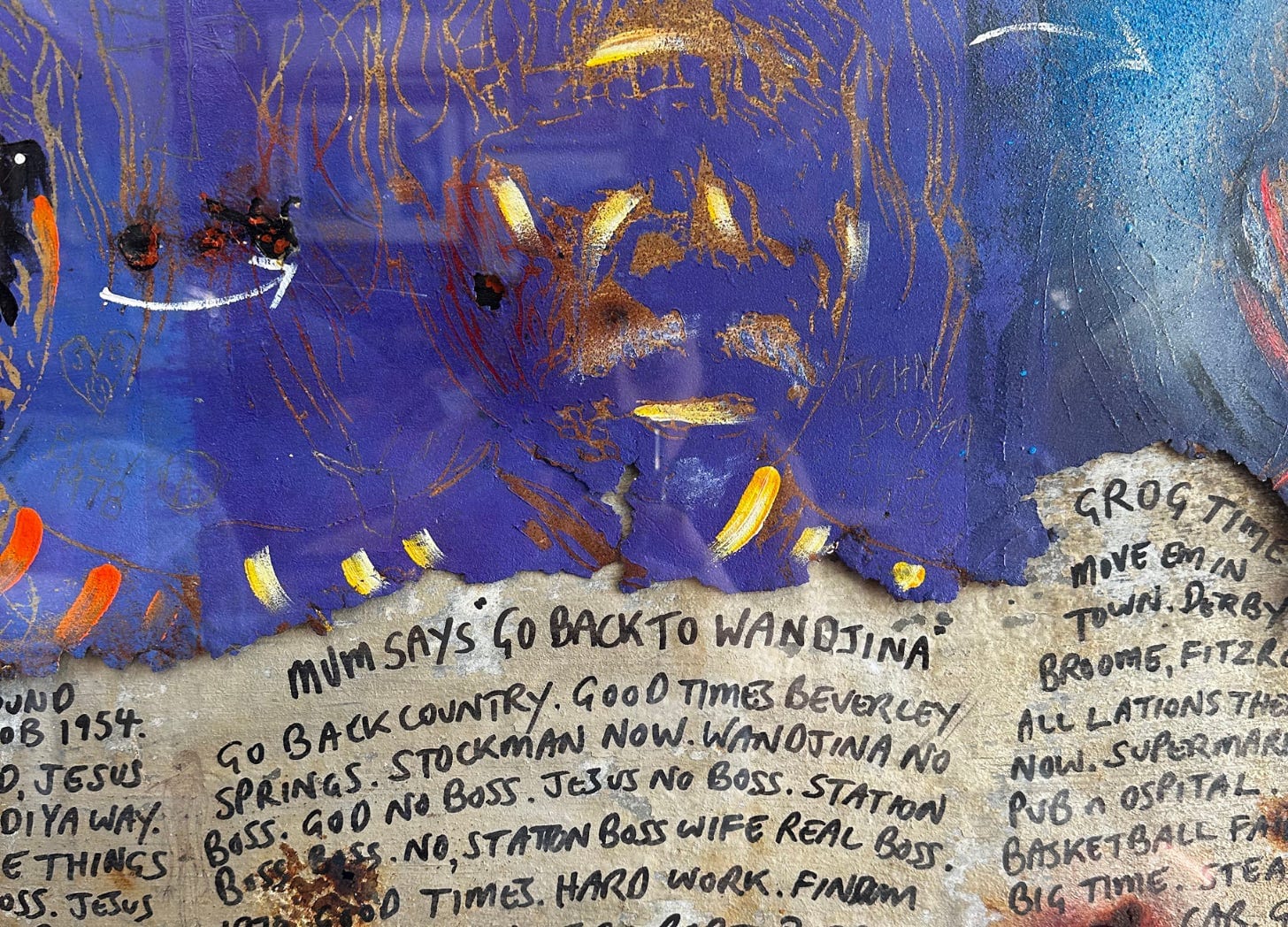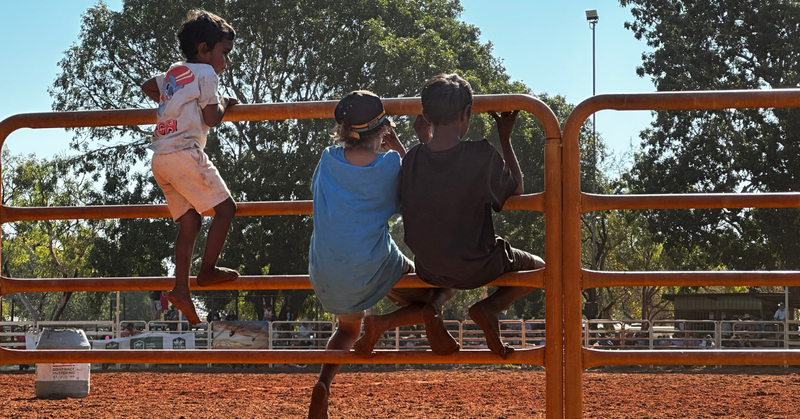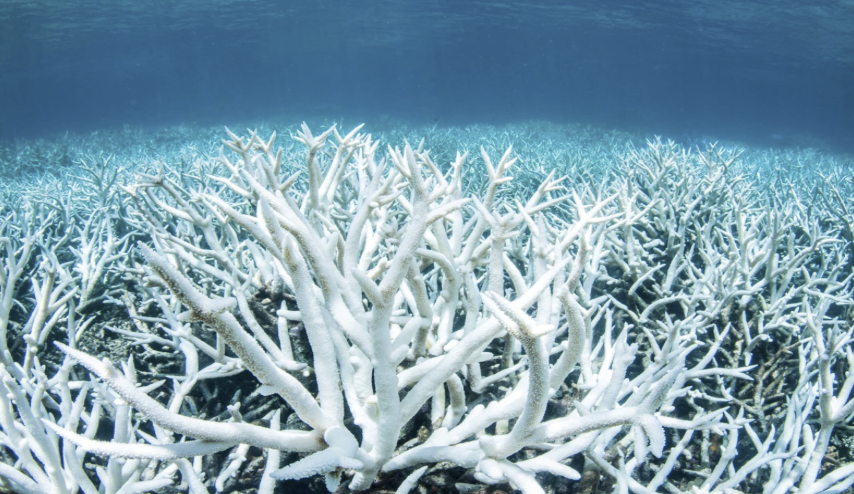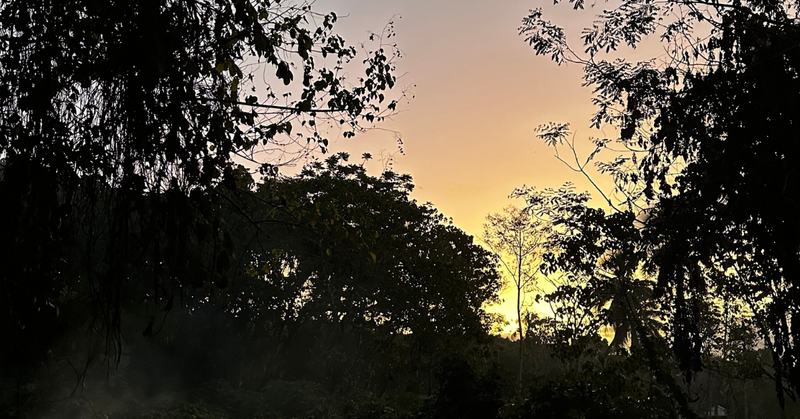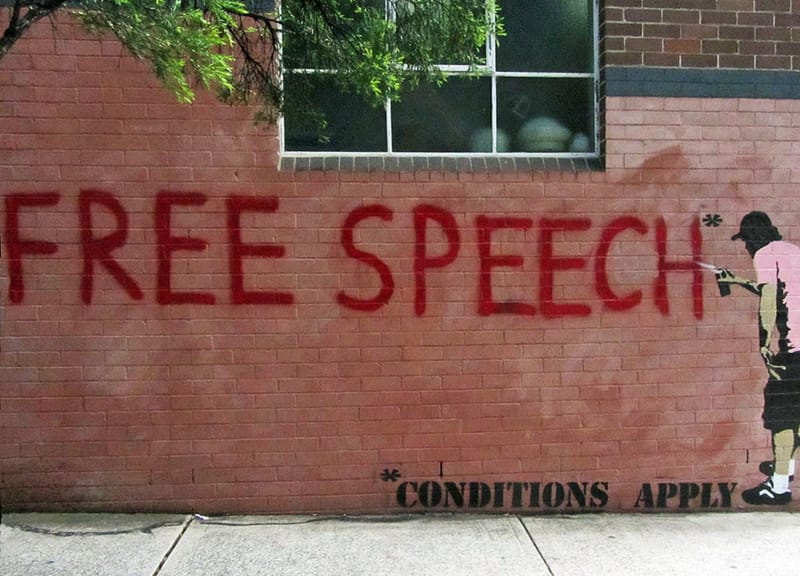There is no going back
Learning from Elders in Australia's remotest region
In the Kimberley, the dust is red and burning under a scorching sun. Termite nests tower towards the sky and tree trunks bear the marks of previous years’ back-burning. The land is flat in all directions, for miles and miles, until suddenly a symmetrical hill raises up out of the ground, perfectly flat on top, like a tupperware container. The distances here are immense. Hundreds of miles of straight roads separate the towns, dotted with carcasses of kangaroos who have leapt in front of a car as dusk falls. Eagles circle up high, becoming scavengers in these parts.
The Kimberley is an immense stretch of land in North West Australia. It was one of the last places to be colonised; after settlers spent 100 years curling up around the massive continent’s coast, they eventually came inland, bringing their droves of cattle. The settlers fenced these lands into giant parcels, forcing the Aboriginal population off the territories they had stewarded for tens of thousands of years, before then forcing them into a form of feudal slavery. It became illegal for Aborigines to not be employed on the stations, and they were paid in flour, sugar and tobacco for multiple generations. Those who ran were chased down by the police. Sometimes White settlers went for joyrides to shoot out the few remaining isolated villages. Men, women and children were rounded up in chains clamped around their necks to live in destitution, labouring under immense heat all day for measly helpings of basic produce. Meanwhile, their lands were stolen, and their rivers siphoned off to feed the bursting livestock population.
I recently spent ten days in the Kimberley with an Aboriginal community who were celebrating the 40th years anniversary of KALAC, an organisation which has helped the local population claw back their cultures and languages from near extinction. I met elders whose mothers walked out of the great sandy desert, whose fathers remembered the first moment they ever saw a White man. Each of these people told me they belong to a country—the word they use to describe their ancestral territory—and that their countries are suffering without them, just as they suffer without their land. These elders are desperately trying to pass on all of their living knowledge to the next generations while they still live. One said he fears that, without this knowledge of how to live on the land, his people will struggle to survive the future. “War is coming,” he said.
It was fortuitous and serendipitous timing that I interviewed Tyson Yunkaporta just before reaching the Kimberley. His words about the necessary interweaving of epistemology and ontology have stayed with me in the weeks since, and shone light on something I had yet to find the words for. Why is it, sometimes, the best intentioned plans go awry? Why is it strikingly difficult to organise collectively in the Western world? Why did post-structuralist discourse fail to impede the rampant growth of colonial capitalism? Tyson made it very clear that we cannot know a thing without living it, and we cannot live a thing without knowing it; knowing and being are intimately intertwined, informing each other, responding to the stimuli of the world, manifesting reality. One without the other is just noise at best and madness at worst.
In the Kimberley, the elders spoke of how the youth are caught between two worlds: their world and the White man’s world. Their attention is pulled in all directions and vague whispers of employment ensnare them in the towns hundreds of miles away. They spend their evenings online, not under the stars. They are distracted. Yet, when they come out on country, into the bush, they transform. I watched a group of boys run barefoot across hot rocks and sharp stones as if it were soft grass, expertly picking ripe fruits and lighting small fires. I watched them perform jaw-dropping acrobatics into cool pools of water, and marvelled at the aim of one in particular who threw rocks over great distances to hit the smallest of targets with utmost ease. They laughed in their shared languages—rarely English—and found artefacts in the sands, stone spearheads that belonged to their ancestors hundreds of years ago. To my amazement, I watched them put each artefact back where they had found it, back in its place for someone else to stumble on and marvel at.
These boys are one with the land here, but they cannot reach it every day. The tiny townships they live in are fenced in, still, by cattle stations. They need a vehicle to get out on country, and a serious 4x4 at that. They always have to eventually return home, where their future opens out in front of them as a restless battle against a continuing violence which annihilated their ancestors, enslaved the rest, and abused the lands and kinfolk they consider family. Many of the boys are angry, as they should be. But in many respects the damage is already done.
To prepare, I read Because a White Man’ll Never Do It by Kevin Gilbert, an aboriginal activist active decades ago. Published in 1973, the book would have the same relevance if it were published tomorrow. Shockingly, it was more radical than many of the texts and ideas that abound today. Gilbert expertly weaved the case for the return of stolen land and compensation, arguing that if Aborigines were not given the funds to begin the process of interweaving their own societies and knowledge into White Australia, the situation would never improve. 50 years on and his words ring true. Some Aboriginal groups have successfully claimed Native Titles to their ancestral land, bringing it under their legal oversight. But without money to live, they are struggling to save it. Mining corporations are now bearing down on the Kimberley causing immense rifts in families. Some see the potential financial windfall as the only chance they’ll get in life.
Without support to practice their culture, it is slowly being lost. Many of the languages are already dead, and the tribal system fractured to fit within the White man’s legal system. Some of their sacred sites have been destroyed, and many rendered inaccessible. These people have every right to be angry. But, incredibly, the Elders did not speak of anger, nor place blame solely at the feet of the White man, which they have every right to. They spoke of their own internal politics, of these aforementioned rifts, of the distracted youth, and of their love for culture and country. They are emblematic of what Tyson spoke of, braiding fact with experience to reveal the complexity of the current situation. One Elder said the reason her culture survived was because a sympathetic station owner allowed her family to practice it. More than an olive branch, this is the gift of an entire olive grove which refuses to rid the big picture of its colour by divorcing it into black and white. The wisdoms I heard were so palpable I felt them in my bones; a far cry from the West’s absolutism that Tyson warned of. When I gently offered the tale of when the commons were enclosed in my own country, Great Britain—heart of the imperial core—and told of how my own ancestors had been forced off the land, their songs and dances and rituals outlawed, they listened in shocked sympathy. “The violence is everywhere,” they told me.
What I learned from the Elders is that the violence cannot be undone; there is no going back to the time before the White man, which they described as happy and peaceful. There is no turning back the clock. They must work with what they have, and keep fighting to gain ground. They are trying to find a way to help the youth be between two worlds so that their songs and dances and Dreams may live on and evolve, so that the land may remember them and welcome them back. From listening to them, I understood that they are trying to move forward by keeping their eyes on their history. They told me that if you do not know who you are and where you come from, you are lost.
One afternoon, as the sun started to sink, I listened to one of the medicine women speak. Veronica is very old, now. Her mother walked out of the great sandy desert many decades ago. She holds so much of the knowledge in her own body, and wants the next generations to know the land because without the land, and without knowing of the land, and how to sing to it, call to it, care for it, they will suffer. She told me about her family tree—an incredible system called “skin group” which interconnects all the people, flora and fauna across all the land. She explained how some trees are her mother and others her cousin, and how some children are her son and others her grandfather, and how the animals, too, are part of this amazing web of interconnection which guides so much of their political, social and ethical practice.
Towards the end, she giggled and said to me: “You must think what I’m saying is funny.”
“No,” I smiled. “I think what you’re saying is the truth.” After, when I helped her take her place near the microphone she sang into every night, along with the other medicine women, I thought about how much we have already lost. Not only culture, language, country, but truth itself. How long will it take us to remember?
